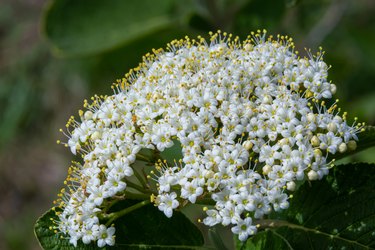
A viburnum bush (Viburnum, USDA plant hardiness zones 2 to 9) is a beautiful but large flowering shrub, and this can complicate a viburnum transplant. You must also move it at the right time of year and under the right conditions. Still, if you follow the proper steps, your plant can thrive in its new home. Learn how to move your viburnum bush as well as how to choose a good spot for it and care for it.
Preparing to Transplant Viburnum Bushes
Video of the Day
Gardening experts recommend transplanting viburnum bushes in the early spring after the last frost. That way, they have ideal growing conditions while adjusting to their new environment. The first step to transplant viburnum must take place a few days beforehand.
Video of the Day
To soften the soil and loosen the roots, thoroughly soak the ground around the viburnum several times. If your plant is in a pot, water it daily so the soil doesn't dry out in between. Note that many municipalities require you to check with local utilities before digging.
Select an ideal spot for your bush and dig a large hole to accommodate the root ball. Viburnum bushes have a snowball bush root system that can grow quite large and heavy. The size of your hole depends on the size and age of the bush. As you dig, put the dirt on a tarp. Combine it with peat and compost at a ratio of two parts ground soil, one part peat and one part compost.
How to Transplant Viburnum Bushes
To begin the process of moving your viburnum bush, dig a trench around it about 1.5 feet deep. Force a pointed shovel or spade into the channel at a 45-degree angle and wiggle it up and down to separate the main root from the outer growth. Do this around the trench.
You may want to have someone assist you with the next step. Grab the viburnum bush by the main trunk and lift it out of the ground. Put it on another tarp or in a wheelbarrow to move it to its new home. Whatever you do, don't let the roots dry out. Ideally, you should transplant it to the hole you prepared immediately. If you have to wait, make sure the root ball stays muddy.
Add enough of your soil, peat, and compost combination so that your viburnum bush sits at the same ground level as its old spot. Then, fill the rest of the hole with the remaining soil mixture and give it an intense watering. Keep the soil moist for a few days.
Caring for Viburnum Bushes
To select the best spot for your viburnum bush, you must understand its needs. Does viburnum need full sun? Ideally, yes. You'll see more berries and blooms the more sunlight it gets. It needs at least 1 inch of water per week.
Your bush viburnum also needs well-drained soil. It can be acidic or basic but should be nutrient-dense. If not, fertilize often. You should prune annually just after the bush flowers to encourage healthy growth.
Viburnum bushes are hardy and resistant to most diseases and pests. They can develop powdery mildew and might fall victim to the invasive leaf beetle, but they're deer-resistant, making them an excellent option for many homes. There is also a range of varieties that grow anywhere from 3 to 15 feet tall.